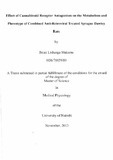| dc.description.abstract | Background: Treatment of Human Immunodeficiency Virus infection with protease inhibitors
and/or nucleoside reverse transcriptase inhibitors often results in development of a
lipodystrophic syndrome whose etiology, phenotype and metabolic derangements resemble that
of general population patients with the metabolic syndrome. Significantly, in metabolic
syndrome patients, an overactive endogenous cannabinoid system is observed and its antagonism
improves physical and biochemical profiles. It can therefore be reasonably expected that the
blockade of this system will prevent the derangements observed in patients with combined antiretroviral
therapy induced lipodystrophy.
Objective: To test the hypothesis that use of a cannabinoid type 1 receptor antagonist
(rimonabant) with combined anti-retroviral therapy prevents the metabolic and phenotypic
derangements associated with chronic combined anti-retroviral therapy in Sprague-Dawley rats.
Design: Randomized Block Design
Setting: Department of Medical Physiology, University of Nairobi
Materials and Methods: Thirty (30) adult male Sprague-Dawley rats housed under standard
conditions were randomized into three groups namely negative control (0.5% starch solution),
positive control (lopinavir/ritonavir + zidovudine) and test (lopinavir/ritonavir + zidovudine) +
rimonabant). The rats received drugs or vehicle by oral gavage daily for 4 weeks. Body mass
index were calculated at weekly intervals, Insulin tolerance test (lTT) was carried out at 2 week
intervals while visceral, and subcutaneous fat depot weight, serum lipids and serum fatty acid
binding protein type 4 were assessed after four weeks of treatment.
Results: The test group had better insulin tolerance than either positive controls or negative
controls. Fasting blood sugar in the test group was 49.7% and 13.8% lower at 120 minutes (P =
0.002) than positive controls and negative controls respectively. Rimonabant treated rats had
39% less visceral adiposity (P = 0.05) than positive controls. Serum triglycerides were 57% and
33% higher in the test group vs. the positive controls and negative controls (P = 0.002)
respectively. LDL cholesterol levels were 102% and 22% higher in the test group vs. positive
controls and negative control rats respectively (P = 0.001). Rimonabant co-administration was
associated with 60% lower HDL cholesterol levels vs. positive controls (P = 0.009). Serum fatty
acid binding protein - type 4 levels were increased by 80% and 75 % in the test group vs.
positive controls and control groups respectively but this was not statistically significant (P =
0.23).
Conclusions and Relevance: Concurrent treatment with the cannabinoid receptor type 1
antagonist rimonabant causes an increase in insulin sensitivity and reduces visceral fat
accumulation. It paradoxically increases serum triglycerides and serum LDL cholesterol levels.
These findings may limit the utility of this approach in addressing combined anti-retroviral
therapy associated lipodystrophy. Further research is necessary to characterize the precise
mechanisms that produced the dyslipidemia observed. | en_US |


